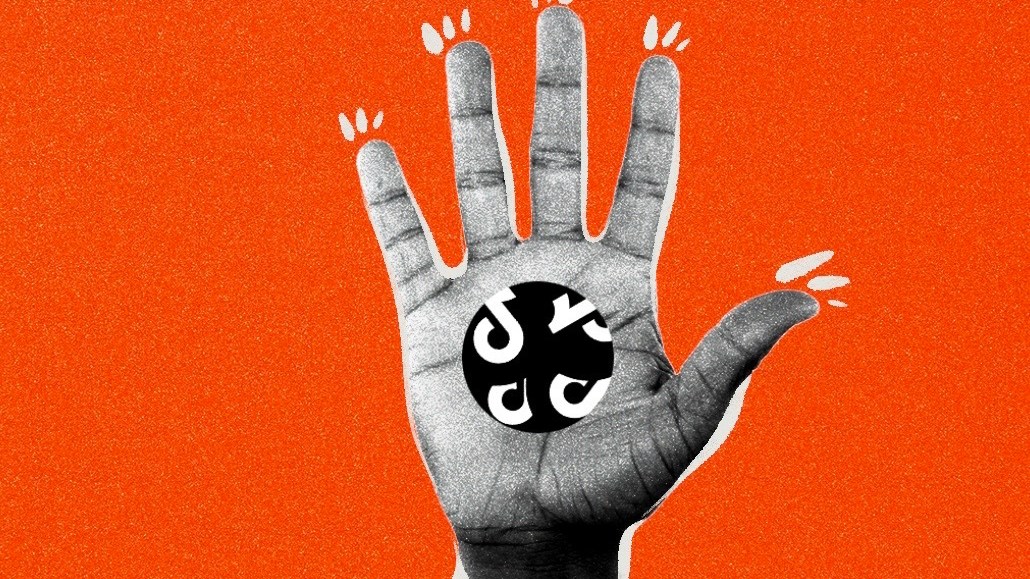Save 50% on a 3-month Digiday+ membership. Ends Dec 12.
Here’s what’s going on with TikTok as it reaches the half-way point of the 75-day extension to its U.S. ban

Today (Feb. 25) marks the half-way point of the 75-day extension TikTok was afforded by President Trump.
While a lot’s happened over the past month, the entertainment platform still doesn’t seem any closer to knowing its fate in the U.S.
Which is why Digiday has checked in on the platform to see exactly where it’s at right now, with just 37 days left to go until the deadline.
TikTok is still losing more top execs
Just before the initial ban deadline (Jan. 19) last month, Digiday reported that a number of its execs were reconsidering their options, having been in touch with executive search firms, while senior leaders were starting to exit the company.
Since then, not a lot has really changed. But while there’s continual uncertainty hanging over its head, the platform is still losing more of its more top execs.
For example, it was reported that TikTok’s global head of music business development and IP rights, Ole Obermann, is leaving the company in March, and is headed for a role at Apple Music. However, it’s understood Tracy Gardner, (TikTok’s head of label licensing and partnerships) will take over Obermann’s role. And on Feb. 20, TikTok’s global head of content strategy and operations, Adrienne Lahens, announced on LinkedIn that she is heading for pastures new.
“After nearly four incredible years at TikTok, I have decided to take the next step,” Lahens posted on LinkedIn. “… As for what’s next? New opportunities and ventures await, and I’ll share more when the time is right.”
While no one has explicitly said their departure is due to the continual uncertainty about TikTok’s U.S. existence, the timing also can’t be ignored.
Neither Obermann nor Lahens responded to Digiday’s request for comment.
But while it can’t be denied that a lot of TikTok staff are still in it for the long-haul, there’s still a lot of uncertainty ahead. According to The Information, during an all-hands meeting held on Feb. 12, TikTok’s CEO Shou Zi Chew hinted at the idea of layoffs, suggesting that leaders will “have to remove unnecessary layers” within teams.
It took a while, but TikTok is back in app stores
On Jan. 18, TikTok was removed from the U.S. Apple and Google app stores to comply with the upcoming ban and law which prohibited the app from being available thereafter.
However, despite President Trump signing an executive order during his first day in office (Jan. 20), which pushed back the deadline for law enforcement for app stores hosting TikTok until April 5, neither Apple, nor Google switched it back on straight away – a key indicator that they were abiding by the law, rather than Trump’s word, at the time.
Fast forward to Thursday, Feb. 13., and TikTok reappeared in both tech giants’ U.S. app stores, after they had received letters from U.S. attorney general Pam Bondi, assuring them that they would not face fines for hosting the app.
Advertisers are still spending on the app until they can’t
With only 37 days to go, advertising on the app seems like it’s still on the up.
Once the app was reinstated to U.S. app stores, CPG advertisers increased their ad spend on TikTok by about 10% on average, according to data from Sensor Tower.
Additionally, e-commerce data from Charm.io found that TikTok Shop’s video ad revenue had increased from around $52.2 million in April 2024, to more than $207.9 million by January 2025 – about a 298% increase in the past 10 months.
Whether this will all continue as we draw closer to the deadline remains to be seen, but what is clear is, advertisers will continue to use the app as much as they can, until they can’t.
Users are back (albeit slowing down) and app traffic is back to normal levels (for the most part)
Unsurprisingly, TikTok got an initial boost in usage thanks to all the talk about the ban, but it now seems to be levelling out.
Sensor Tower data showed that since the app was reinstated to U.S. app stores, U.S. mobile app downloads increased 165%, while data from Similarweb revealed that daily active users on the app are down 6.8% month over month, and 3.1% year over year.
Data from Similaweb, however, found that web traffic is down by about 4%, based on month-to-date data for February, but it is up 17.6% year over year. At the same time, it was reported by CNBC that TikTok’s U.S. traffic had nearly bounced back to its original traffic levels following its 14-hour shut down last month.
Questions still being asked about how important TikTok U.S. really is to ByteDance
Investors are investors and their priority will always be getting a return on their investment, whatever that might be. And that goes for those American investors who have put capital towards ByteDance.
And while no one is suggesting that any investor (or anyone at all) wants a U.S. TikTok ban, because the platform does still have a lot of potential there, Bloomberg did report that 80% of ByteDance’s revenue comes from its Chinese products like Douyin. So while a loss of TikTok in the U.S. would definitely be inconvenient, and likely frustrating for all involved, it likely won’t hurt ByteDance’s overall revenue too much.
It’s still business as usual for TikTok
Since President Trump signed his 75-day executive order, everything appears to have gone quiet so far.
Which is to say that TikTok is operating business as usual. Not a huge surprise, given the “keep calm and carry on” approach has been TikTok’s stance ever since the threat of a ban became reality in April 2024 when former President Biden signed the bill.
Still, 10 months on and TikTok still doesn’t appear to be that worried. Instead, the app has recently launched automotive ads – a performance ad offering to enable advertisers to target users based on their specific vehicle interests and likes, with the likes of Peugeot U.K. and TurnKey Marketing as early adopters. And there are still 2148 open vacancies for roles across the U.S.
All this is to say, TikTok must have a certain amount of confidence – as it always has – that it won’t be leaving U.S. shores anytime soon and its existence in North America will continue far beyond its current 75-day extension window.
TikTok declined to comment on this article.
More in Marketing

How Costco stood against Trump’s agenda on tariffs, DEI this year
Costco has continuously been held up as an example of a company that has stood firm in its willingness to do what it believes is best for the business.

Brands look to experiential marketing as antidote to AI slop, digital fatigue
Brands are prioritizing experiential and IRL marketing as an antidote to ‘AI slop’ and digital fatigue.

Agencies push curation upstream, reclaiming control of the programmatic bidstream
Curation spent much of this year in a fog, loosely defined and inconsistently applied. Agencies say they plan to tighten the screws in 2026.







